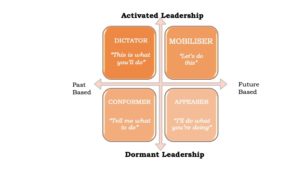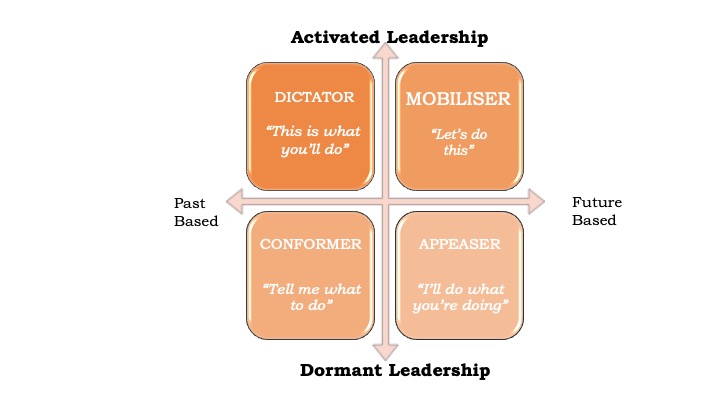I have found the following 4 leadership styles useful in diagnosing where leadership sits in an organisation, and helping people develop a more impactful and empowering way of creating change. In looking at these, is there one that you default to?
The 4 quadrants are Dictator (‘this is what you’ll do); Conformer (‘tell me what to do’), Appeaser (‘I’ll do what you’re doing’) and Mobiliser (“Let’s do this!”).
In a certain environment you might be more one style than the other. That’s because our leadership ability isn’t fixed and definitive. Different environments and contexts promote or inhibit effective leadership.

If you’re a Dictator, you
- believe only you can do it
- have to succeed, and if you don’t, you need to cover it up
- give directions, and get annoyed when people don’t do it the way you say
- don’t like being questioned
- believe only a few can truly lead, and the majority have to be told what to do
- exert ‘power over’
If you’re a Conformer, you
- make things happen that others have decided
- follow orders, even if you don’t agree with them
- tow the party line, even if it goes against your own values
- derive your power by your proximity to it
If you’re an Appeaser, you
- don’t really stand for something
- are agreeable, and don’t make waves
- don’t believe you are a leader
- are a good cheerleader. You say what people want to hear
- Avoid confrontation
If you’re a Mobiliser, you
- can be found in any part of the organisation
- believe in the inherent ability every person has to lead
- work for a future worth creating.
- have a clarity of purpose, and a vision that inspires
- ‘walk the walk’ – and you walk beside others
- take ownership for how you show up.
- exercise ‘power with’ and ‘power to’
Have a think about which one you default to, and in what context. Bear in mind, these are not personality traits. They are ways of leading, or failing to lead.
One of my clients realised he can be a Dictator with his team, telling them what to do, and feeling his position was not as respected as he’d like. Yet he would show up as a Conformer with his boss and CEO, executing plans he knew were only half thought through, but not speaking up about it. Neither leadership styles were empowering him. When he was in Dictator mode, he created resistance and resentment in the people he needed to grow the business. As a Conformer, he felt compromised in not expressing his leadership through contributing insights that might influence decisions made at the top. Moving to a Mobiliser style, and understanding how to do this, bought his effectiveness as a leader into alignment and focus.
Teams also can have a bias around one of the styles.
One team I worked with was very Appeaser heavy. There were lots of ‘yes’s’ and excitement, but a disappointing ability to actually make something happen. As appeaser’s, the culture was to wait and see what was popular or safe before acting. At a personal level, the need to be liked drove what people said or did. As you can imagine, little growth happened there. The tough leadership conversations that have to happen, and the rigour that needed to be bought to strategy and execution just wasn’t there. Understanding how to be Mobilisers changed the game. They moved their leadership dynamic from Dormant (below the line), to Activated (above the line). The team kept the closeness of relationships they had with each other, but sharpened it around purpose and impact.
Wherever you or your team is in your leadership style, the good news is there are ways to move yourself and your team to be in the Mobiliser quadrant more often. This gives you access to an influence and power that can change organisations and societies! Mobilisers engage. They make things possible.





